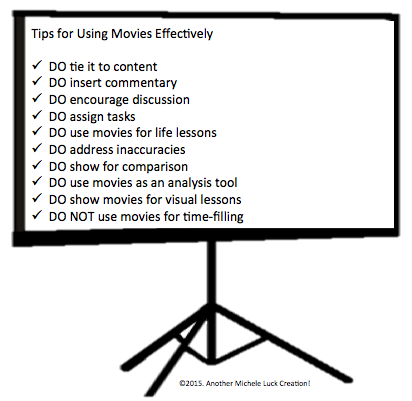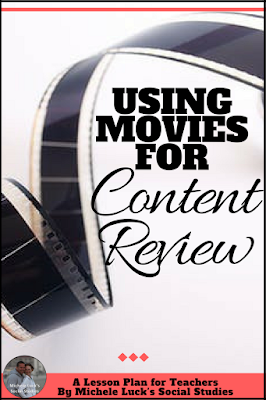When people talk about movies being shown in classes, I usually cringe. My first thoughts go to those teachers who sit at their desks all year, never actually teaching, and only showing movies to inform their students. Sadly, those types of teachers have created a negative impression of something that can actually be a valuable tool in the classroom.

Many movies actually provide incredible stories that can help our student visualize history. When you add in the entertainment factor, students are much more likely to pay attention, and to remember what you’ve been trying to tell them all along! Unfortunately, on the flip side, many movies are also horribly inaccurate. But this is okay!
Using movies can serve many purposes, IF done correctly, and only if done infrequently. And as test prep and testing take over classrooms in the spring season, movies can help to review content already taught in a new and different method.

- DO
tie it to content: Use movies that address the content you are teaching, and emphasize the facts over the fiction the movie shares. - Schindler’s List is filled with great information on the Holocaust and persecution of the Jews. Add Nuremberg (the TNT version), and you have a great review of the Holocaust and the trials following.
- DO
insert commentary: Stop the movie after significant scenes to clarify key topics or to insert content that is missing. - Mona Lisa Smile is a great movie that addresses many questions about equality in the 20th century. Stop and add in the legislation passed in the same time periods to enhance the content significance.
- DO
encourage discussion: Review scenes and ask students their thoughts on the topics addressed. Encourage controversy and debate! - Saving Private Ryan has incredible scenes depicting WWII, but it also addresses very sensitive subjects on war. Stop and talk about them, and be open to accepting varying perspectives.
- DO
assign tasks: Use viewing guides or note-taking tools for movies. It’s still a class, not just a social event! - Avatar is an incredible movie for reviewing Imperialism, but the value is lost if that direct comparison is not made. Use guides to direct your students’ attention and to address the correlation.
- DO
use movies for life lessons: Some movies provide valuable life lessons that cannot be taught with words or worksheets. - One of my favorite movies is The Emperor’s Club with Kevin Kline. It teaches both students and teachers some valuable lessons about learning. It’s worth the watch, especially at testing time!
- DO
address inaccuracies: Teach students to evaluate what they see… What do they know is inaccurate or exaggerated? - Show Forest Gump just before testing? Of course! But do so as a lesson on the inaccuracies in movies. Allow students to keep their notebooks on hand to identify and describe the misinformation.
- DO
show for comparison: Compare movies to movies, movies to primary sources, or movies to lecture notes. What is similar? What is different? - How do Roots and Amistad tell the same stories? What differences do they depict?
- DO
use movies as an analysis tool: Critical thinking and analysis are vital in everything we see and do in our modern world. Analyze the movies as you would any document or image. - How better can you describe the social and political tension of the 80s than by showing The Breakfast Club and Red Dawn? Analyze them separately and together for a clearer understanding of the decade.
- DO
show movies for visual lessons: Reach your visual learners with movies and enhance learning for all of your other learners. - Do you remember how we watched and ENJOYED Schoolhouse Rock when we were kids? They still have the same power for our youngest generation! Try it and see!
- DO
NOT use movies for time-filling: This is never a good idea. It teaches students that your class time is not valuable, and that everything we see in the movies is real. - There is no value in any movie (or lesson) that has no purpose!
Like any other tool you use in your classroom, movies are what you make them. Don’t simply watch movies – TEACH them!
Want to read more? Take a look at this website with ideas and tools for using movies in your classroom!

Happy Teaching!